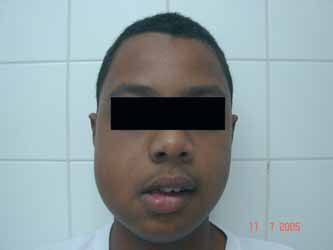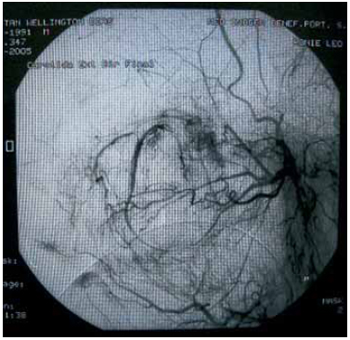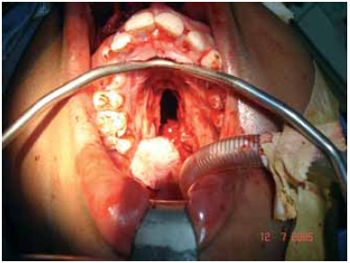INTRODUCTIONNasopharyngeal angiofibroma is described as a rare and benign disease, which is mainly diagnosed in male adolescents. It is a highly vascularized slow growing tumor, but locally invasive and destructive. Originating in the margin of the sphenopalatine foramen, it extends itself to the pterygopalatine fossa, paranasal sinus and nasal cavity, leading to symptoms such as pain, unilateral nasal obstruction and epistaxis. If developed, such tumor causes facial distortions, and it can affect both the orbit and intracranial area, leading to symptoms such as proptosis, alterations on visual acuteness and palsies on cranial nerves. There is no agreement in the literature in terms of angiofibroma treatment. Several surgical approaches have been described for large tumors, including transpalatal, lateral rhinotomy and midface degloving procedures. Associated with any of these, preoperative embolization of tumor has been recommended in the literature to decrease intraoperative blood loss.
The target of this study is to report a case of a patient with nasopharyngeal angiofibroma associated with literature revision focusing on surgical approaches used, on results from diffrent stages, on preoperative embolization and on reccurent rates of tumors.
LITERATURE REVISIONWe revised the literature focusing on the used surgical techniques, on results from different stages, on the usage or not of preoperative embolization and on recurrent rates of tumors.
Several aproaches are used according to tumor localization: transpalatal, transmaxillar, lateral rhinotomy, midface degloving and osteotomy Le Fort type I. Revision of 35 cases in Japanese literature, between 1990 and 2003, showed that surgical approaches on different stages were: transpalatal (11 cases; 31.4%), transmaxillar (9 cases; 25.7%), transnasal (6 cases; 17.1%) and others (25.7%). Recidive rate was: 5% on stage I, 38% on stage II and 33% on stage III. Transpalatal apprach had the highest rate of recidive on stages II or on more advanced stages.1
Endoscopic removal of the nasopharyngeal angiofibroma is efective and safe; and such approach does not seem cause recurrence. 2
Endonasal surgical techniques and the use of surgical microscope in midface degloving lead to a well-successed removal of extra and intracranial tumors. These authors do not recommend endonasal approach on stage IV and on some cases of stages III with greater extension to mid cranial fossa.3 Intracranial invasions are present from 10 to 20% of patientes.4
Past studies from 32 patients treated for nasopharyngeal angiofibroma for more than 14 years showed, after estatistical analysis, that the average age was 16 years and more than 90% of patients presented the disease on stages III and IV. Preoperative embolization was performed in 19 patients (59.37%). The used approaches were: mid maxillectomy, infratemporal fossa, transpalatal and facialcranial. These authors reported: rates of recurrence, complete resection and healing were respectively 12.5%, 41% and 63%.5
Transpalatal route is limited to nasopharinx tumor, nasal cavity and sphenoid sinus, hence complete exposure of the lateral extension of tumor is not possible. Denker´s approach together with partial maxillectomy allows resectin inside nasal cavity of the nasopharynx and paranasal sinus. Tumors extending to infratemporal fossa and cavernous sinus can be approached by a combination beteween Denket and paranasal route. Midfacial approaches can be also considered in these situations. Lateral rhinotomy is effective to exposure nasopharynx, paranasal sinus, pterygopalatine fossa, mid portion of the infratemporal fossa and cavernous sinus Surgical approach should be chosen according to effectiveness of embolization and surgion experience.4
Transpalatine route can be used in a routine manner in tumors limited to rhinopharynx. Transpalatine route is completed by sublabial transantral route in tumors extending to nasal cavity and/or sphenoid or even in those which occupy the following cavities: maxillar, ethmoidal sinus, pterygomaxillary fossa, orbit and cheeck. Paralateronasal and paralateral mesolabial routes provide good exposure of tumor, though they present esthetical disadvantages when compared with sublabial route. 6,7
Transnasal endoscopic approach is better recommended for small tumors limited to nasopharynx, nasal cavity, ethmoidal and sphenoidal sinus, and it can also be applied to tumors extanding to pterygopalatine fossa or be used together with other approaches in order to evaluate tumor extension and resection suffiency.9
Correlation between preoperative staging and surgical findings, through CT and MRI, was studied and agreed in 92% of the cases. In 17%, CT and MRI showed recurrence after surgery. CT allows right staging of tumor and also shows the presence and extension of recurrence. 8 MRI is ideal to evaluate lesion and to obtain information from this mass with adjacent structures (orbit, durameter, internal carotid and cavernous sinus).10
The main artery supply of these tumors is ipsilateral maxillary artery, though branches either of ipsilateral internal carotid artery or of contralateral external carotid system may exist. Surgical approach should be determined by effective embolization and by size and localization of tumor.11
Selective arterial embolization leads to a reduction of blood loss during surgery and makes tumor removal easy. The worst implication for this procedure would be embolization to intracranial circulation, though it is rare. Other implications associated with embolizations are: systemic reaction to contrast, infection in the place of punction, hematoma and thrombosis of the femur. Although arterial embolization reduces intraoperative bleeding, it can increase risk of recurrence, specially if profound invasion of sphenoid occurs, though this makes removal more difficult. Therefore, patients, who present such invasion at preoperative tomography exam, are under risk of recurrence and embolization is not recommended. 9
In 14 reported cases, angiography revealed that the main supply of tumor was maxillary artery, but in four cases also occurred ascending pharyngeal artery.4
The differential diagnoses which might be remembered are: inflammatory polyps; angiomatous polyp, and nasopharyngeal cist; nasopharyngeal fibrosarcomas and fibroma; nasal fossa esthesioneuroblastoma; malignant neoplasm of the superior maxillary; malignant tumor of nasopharynx and adenoid hypertrophy (easily distinguished by its clinical presentation and endoscopic aspect). 6,9
CASE REPORT14-year-old-male patient, brownish skin, 9-month-history of right hemiface increase with ipsilateral nasal obstruction with no nasal bleeding. The physical exam presented facial distortion to the right, with no sight or eye alterations (Picture 1). Previous rhinoscopy showed tumor in all right nasal fossa and nasal septum displaced to the left side. Oropharyngoscopy showed soft palate in bulging condition. Tomography showed heterogeneous mass in all right nasal fossa, nasopharynx, pterygopalatine fossa, infratemporal area and sphenoid sinus (Picture 2). MRI neither showed tumor extension in the orbit, in cavernous sinus nor intracranial. 96 hours before proceduring it was performed selective embolization of maxillary, accessory meningeal and ascending pharyngeal arteries (Picture 3). This contributed to surgical approach with tumor removal via transplatine associated with midfacial degloving (Pictures 4 and 5)

Picture 1. Facial deformity to the right, observed to the exam physical.

Picture 2. T.C. (coronal): mass heretogênea in the whole sewage nasal right, nasofaringe, ptérigo-palatine sewage, area infratemporal and breast esfenóide.

Picture 3. Preoperative Embolização.

Picture 4. Surgical approach: through transpalatina associated to the medium-facial degloving.

Picture 5. Surgical approach: through transpalatina associated to the medium-facial degloving.
Anatomopathological exam showed findings compatible with hypothesis.
The removal of tumor was possible through these surgical approaches.
Bleeding did not occur after surgery and we could observe fair reduction on facial asymmetry two weeks after tumor removal. We made use of Acrylic plate in order to protect mucosa suture of the palate and to early introduction of oral feeding. The follow-up has been doing with clinical evaluation and nasal endoscopic exam and rhinopharynx. In order to control recurrence, CT will be performed, though recurrence rates are high in stage III - FISCH.
Recurrence is a constant worry in these patients, and it is mentioned in the literature an incidence from 6% to 24%8 and 33% in stage III. 1
DISCUSSIONThe treatment for Juvenile Nasopharyngeal Angiofibroma is questionable. Some authors prefer a waiting behavior, others recommend radiotherapy, hormone therapy or surgery. Surgery is preferred among all, but it is difficult to be performed because of vascular component of tumor and because of lesion extension and exposure.
The access route can be transplatine, endonasal, tranpharyngeal, Rouge-Denker and transmaxillar.
There is no agreement in literature on the best surgical option. Lesion extension, suitable exposure and complete extinguishion of tumor should be taken into consideration. The application of endoscopic techniques is one of the options for treatment of more limited lesions; it has been developed, but it is still reserved for tumor in stage I and II from FISCH classification.
The most used surgical approach is transmaxillar and as a second option transpalatine. In transmaxillar route it was done incision through lateral rhinotomy, which can be extended to superior midlabial area or through sublabial incision. Transpalatal approach is useful in Juvenile Nasopharyngeal Angiofibroma limited to nasopharynx with minimum extension to sinus or pterygopalatine fossa; it offers excellent exposure to this area with minimum morbidity and excellent cosmetic result. 6,7
Nowadays we make use of selective arterial embolization for the possibility of severe hemorrhage during surgery. This technique not only reduces blood loss during surgery but also makes tumor removal easy.
CT allows preoperative staging and detection of recurrence. The high rates of recurrence on advanced tumor stages justifies careful post-surgery follow-up.
Radiotherapy can be done when there is great tumor mass and/or intracranial invasion, especially invasion of durameter, cavernous sinus and pituitary fossa, where comprehensive surgical resection is difficult and risky, or even in cases of recurrence. 9 Radiotherapy and hormone therapy can be recommended either in cases of large tumors in which surgical excision was partial or in recurrences.
In stage III from FISCH classification there is a need of better exposure of tumor and it was chosen, in this case, midfacial degloving associated with transpalatine technique, leading to a comprehensive removal of lesion. 11
FINAL COMMENTSRevising literature, it can be observed that most of authors recommend radical surgery as the most effective treatment.
Surgical approach depends on disease extension, on surgeon experience and preoperative selective arterial embolization should be performed whenever it is possible. Post-surgery follow-up should aim both detection of presence and extension of recurrence.
BIBLIOGRAPHY1. Hanamure Y, Tanaka N, Kawabata T, Kasano F, Kashima N. Juvenile nasopharyngeal angiofibroma: stage and surgical approach. Nippon Jibiinkoka Gakkai Kaiho. 2005;108(5):51321.
2. Pryor SG, Moore EJ, Kasperbauer JL. Endoscopic versus traditional approaches for excision of juvenile nasopharyngeal angiofibroma. Laryngoscope. 2005;115(7):12017.
3. Mann WJ, Jecker P, Amedee RG. Juvenile Angiofibromas: changing surgical concept over the last 20 years. Laryngoscope. 2004;114:2913.
4. Scholtz AW, Appenroth E, KamenJolly K, Scholtz LU, Thumfart WF. Juvenile nasopharyngeal angiofibroma: management and therapy. Laryngoscope. 2001;111:6817.
5. Mistry RC, Qureshi SS, Gupta S, Gupta S. Juvenile nasopharyngeal angiofibroma: a single institution study. Indian J Cancer. 2005;42(1):359.
6. Granato L. Angiofibroma Juvenil - Vias de Abordagem, Técnicas e Complicações. In: Brandão LG, Ferraz AR. Cirurgia de Cabeça e Pescoço, São Paulo: Editora Roca; 1989. Vol 2. p.397-414.
7. Butugan O. Angiofibroma Juvenil - Aspectos Atuais Terapêuticos. In: Brandão LG, Ferraz AR. Cirurgia de Cabeça e Pescoço. São Paulo: Editora Roca; 1989. Vol.2. p.415-20.
8. Szymanska A, Golabek W, Siwiec H, Pietura R, SzczerboTrojanowska M. Juvenile angiofibroma: the value of CT and MRI for treatment planning and followup. OtolaryngolPol. 2005;59(1):8590.
9. Ricardo LAC, Tiago RSL, Fava AS. Angiofibroma Nasofaríngeo: Revisão de Literatura. Rev Bras ORL. 2003;69(3):394-403.
10. Nicolai P, Berlucchi M, Tomenzoli D, Cappiello J, Trimarchi M, Maroldi R, et al. Endoscopic surgery for juvenile angiofibroma: when and how. Laryngoscope. 2003;113:77582.
11. Granato L. Angiofibroma Nasofaríngeo Juvenil. In: Campos CAH, Costa HOO. Tratado de Otorrinolaringologia. São Paulo: Editora Roca; 2002. Vol.3. p.701-11.
1. Master in Medicine - Concentration in ORL - FCMSC-SP (Doutoranda in Medicine - Concentration in ORL - FCMSC - SP Preceptora of the Clinic of ORL - HSPM - SP)
2. Doctor in Otorrinolaringologia (Attached Teacher of the Department of Otorrinolaringologia of FCMSC - SP)
3. Doctor (Resident of 1st year of the Clinic of ORL - HSPM - SP)
4. Doctor (Resident of 3rd year of the Clinic of ORL - HSPM - SP) Hospital of the Municipal Public Servant - SP.
Address for correspondence: Dra. Fátima Regina Abreu Alves. Av. Moema, 801. São Paulo / SP. ZIP CODE: 04077-023. e-mail: ffraa@terra.com.br
This article was submitted in SGP (System of Administration of Publications) of the RAIO in 19/1/2006 and approved in 29/4/2006 16:23:29.